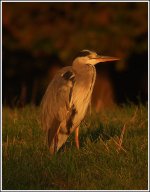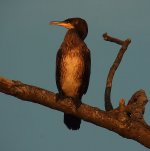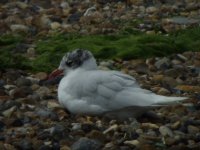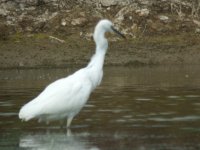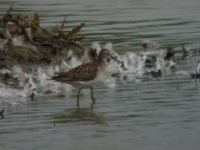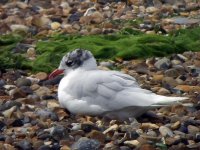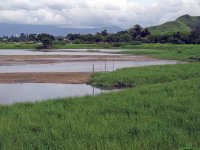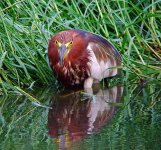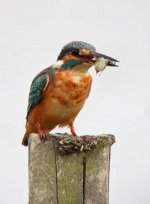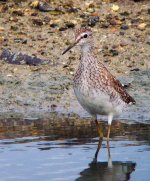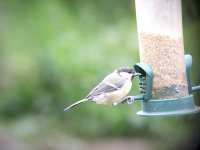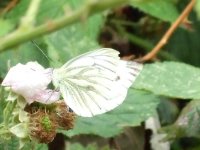-
Welcome to BirdForum, the internet's largest birding community with thousands of members from all over the world. The forums are dedicated to wild birds, birding, binoculars and equipment and all that goes with it.
Please register for an account to take part in the discussions in the forum, post your pictures in the gallery and more.
You are using an out of date browser. It may not display this or other websites correctly.
You should upgrade or use an alternative browser.
You should upgrade or use an alternative browser.
First day with Fuji F31fd (1 Viewer)
- Thread starter Paul Corfield
- Start date
More options
Who Replied?NoSpringChicken
Well-known member

Neil, this sounds remarkably like the problem I was talking about in this thread:
http://www.birdforum.net/showthread.php?t=90440
Perhaps I should have increased the ISO number a bit more to get a faster shutter speed or switched Macro off. I haven't actually had the problem lately but that might be down to the lighting conditions I have encountered.
I look forward to reading the results of your tests but it is very late now and time for bed.
Ron
http://www.birdforum.net/showthread.php?t=90440
Perhaps I should have increased the ISO number a bit more to get a faster shutter speed or switched Macro off. I haven't actually had the problem lately but that might be down to the lighting conditions I have encountered.
I look forward to reading the results of your tests but it is very late now and time for bed.
Ron
Paul Corfield
Well-known member
Since I got my camera set up on the foxfoto adapter and mounted to the scope a couple of weeks ago I hardly ever get the af problem anymore. I rarely go into macro mode and haven't noticed any difference in photos where I do or don't use it. I started using the multi focus instead of the center focus a lot more too so maybe that helps. For daytime I tend to leave the ISO set to Auto400 and when it's getting dark I up it to Auto800. I leave the aperture down to the camera to work out rather than setting it myself.
Here's a couple of photos from the last few days. Both around 40 meter range at sunset.
Paul.
Here's a couple of photos from the last few days. Both around 40 meter range at sunset.
Paul.
Attachments
NoSpringChicken
Well-known member

Nice lighting in those photos, Paul, especially the Heron.
Your camera settings are quite interesting too. I guess you are using the Manual mode to get the Auto400 setting. It seems a strange name to me as there is very little manual control over the settings. The Auto400 setting would save a lot of fiddling about and I never seem to have enough time to check everything before I take a photo. My F30 only has Auto400 or Auto1600. Is the F31 different?
I imagine the Multi focus works best when there is a single subject with a contrasting background, rather than trying to pick out a bird from surrounding branches for example. I will give it a try.
You seem to be getting on well with your set up. Nice work.
Ron
Your camera settings are quite interesting too. I guess you are using the Manual mode to get the Auto400 setting. It seems a strange name to me as there is very little manual control over the settings. The Auto400 setting would save a lot of fiddling about and I never seem to have enough time to check everything before I take a photo. My F30 only has Auto400 or Auto1600. Is the F31 different?
I imagine the Multi focus works best when there is a single subject with a contrasting background, rather than trying to pick out a bird from surrounding branches for example. I will give it a try.
You seem to be getting on well with your set up. Nice work.
Ron
Paul Corfield
Well-known member
Yeah, on the F31 you also get an Auto800 as well as the Auto400 and Auto1600.
Paul.
Paul.
birderbill
Well-known member
Spent the day photographing waders and gulls today and rattled off about 150 images. on my return home and after downloading the images to the computer I was dismayed to see that most of the images were just out of focus or less than sharp. Is this typical digiscoping or can any one give me some tips on sharpening up the image or playing with the Fuji 31 controls?
I've attached some examples !
I've attached some examples !
Attachments
Bill,
I had a look at these images on my computer. It looks like the focus was off as well as high magnification in low light over water. If you look at the egret you can see that the background is quite sharp and the bird is way out of focus. With the long camera zoom that you were using I assume you had switched off Macro Mode as mentioned in previous posts as the camera would have had problems with focusing (the little Green light would have been flashing ). For small subjects in the frame it's best to use Spot Metering. Most people are using A/S Mode, rather than Program. Always a good idea to keep checking focus in the scope.
It is difficult though, particularly if the light is not good. I'm going out to the wetlands today in rain so I'm not expecting too much. Neil.
I had a look at these images on my computer. It looks like the focus was off as well as high magnification in low light over water. If you look at the egret you can see that the background is quite sharp and the bird is way out of focus. With the long camera zoom that you were using I assume you had switched off Macro Mode as mentioned in previous posts as the camera would have had problems with focusing (the little Green light would have been flashing ). For small subjects in the frame it's best to use Spot Metering. Most people are using A/S Mode, rather than Program. Always a good idea to keep checking focus in the scope.
It is difficult though, particularly if the light is not good. I'm going out to the wetlands today in rain so I'm not expecting too much. Neil.
Paul Corfield
Well-known member
Personally I just don't think the Leica is all that good for digiscoping. I had a look through the galleries and couldn't find anyone getting consistent results with that scope. All the photos look soft or they look like they've been sharpened loads. I did a bit of hunting around on the web also and it seems that soft photos is something that this scope suffers from. I've never looked through one but I'm sure they are great at what they are designed for.
As I've shown with my very inexpensive homemade hybrid setup, digiscoping isn't all down to very expensive optics. Having tried various very cheap objective lenses in my scopes and still getting the same results I find it all comes down to the eyepiece and that's the area that makes the most difference for me in sharpness. I think what works well for digiscoping isn't always that which works well for looking through. I can't really fault the camera as I'm using the same one.
Paul.
As I've shown with my very inexpensive homemade hybrid setup, digiscoping isn't all down to very expensive optics. Having tried various very cheap objective lenses in my scopes and still getting the same results I find it all comes down to the eyepiece and that's the area that makes the most difference for me in sharpness. I think what works well for digiscoping isn't always that which works well for looking through. I can't really fault the camera as I'm using the same one.
Paul.
birderbill
Well-known member
Neil & Paul,
Thanks for your advice.
I was using the manual mode on the camera and adjusted for light at -1. I did play around with ISO's too. I've only had the camera a few weeks so its still very early days and I've not really played much with A/S either. After reading through the manual again I need to think about the metering modes more and will take the advice on spot focus! Clearly more work needs to be done on close and easy stuff first, then I can start increasing my distances.
I was interested in the comments about the soft digiscope images through the Leica, without the camera on the scope is incredibly sharp and deals really well with different levels of light. The camera is excellent and as with Paul I can't really fault apart from having to reset most of the settings when it switches off- maybe a savable personalised mode with pre-sets would be a good thing? I'd be interested in other Leica users comments about the soft image issue.
I haven't started to play with software in order to sharpen up images. All I have at the moment is the disc which came with the camera and the software that this brings. Is Noiseware similar to Photoshop? What other good photo' software programs are there?
Thank you again.
Bill
Thanks for your advice.
I was using the manual mode on the camera and adjusted for light at -1. I did play around with ISO's too. I've only had the camera a few weeks so its still very early days and I've not really played much with A/S either. After reading through the manual again I need to think about the metering modes more and will take the advice on spot focus! Clearly more work needs to be done on close and easy stuff first, then I can start increasing my distances.
I was interested in the comments about the soft digiscope images through the Leica, without the camera on the scope is incredibly sharp and deals really well with different levels of light. The camera is excellent and as with Paul I can't really fault apart from having to reset most of the settings when it switches off- maybe a savable personalised mode with pre-sets would be a good thing? I'd be interested in other Leica users comments about the soft image issue.
I haven't started to play with software in order to sharpen up images. All I have at the moment is the disc which came with the camera and the software that this brings. Is Noiseware similar to Photoshop? What other good photo' software programs are there?
Thank you again.
Bill
Paul Corfield
Well-known member
There's an article here by Laurence Poh, the supposed father of digiscoping. It's about his struggle with the Leica's soft images and his eventual change to a Swarovski. http://www.digiscoping.com/static/digiscoping_update.shtml
Noiseware is software for removing background noise in photos. I use the Neat Image plug-in for photoshop and find it does an excellent job. Also look at the very popular free download called Irfanview. I tend to use that for sharpening and run a photo through it twice for sharpening and then adjust levels etc in Photoshop. Photoshop does a good job at sharpening too but I sometimes prefer Irfanview for tht job plus it's free. The Neat Image noise remover plug-in also works in Irfanview as do most Photoshop plug-ins. Visit http://www.irfanview.com/
Paul.
Noiseware is software for removing background noise in photos. I use the Neat Image plug-in for photoshop and find it does an excellent job. Also look at the very popular free download called Irfanview. I tend to use that for sharpening and run a photo through it twice for sharpening and then adjust levels etc in Photoshop. Photoshop does a good job at sharpening too but I sometimes prefer Irfanview for tht job plus it's free. The Neat Image noise remover plug-in also works in Irfanview as do most Photoshop plug-ins. Visit http://www.irfanview.com/
Paul.
Newton Stringer
Well-known member
Hi
I use the F31 with a leica 62 apo.... I find most of my images are a little soft and need a play in photoshop to sharpen them to some degree, however I'm still happy with the final results...
I'm a total novice and just getting to know the set up, finding it hit and miss, but I gather that is the nature of all digiscoping ? Out of 150 shots I may get 10 half decent ones that i then sharpen a bit. I just figured that all scopes produced the same results ? Is there a scope that produces good sharp images without the need for sharpening then ?
All images on my web site were taken with the F31/leica apo 62 combo... a few bird pics on this page
http://www.freewebs.com/newtonstringer/newtonthebirdingpatch.htm
I use the F31 with a leica 62 apo.... I find most of my images are a little soft and need a play in photoshop to sharpen them to some degree, however I'm still happy with the final results...
I'm a total novice and just getting to know the set up, finding it hit and miss, but I gather that is the nature of all digiscoping ? Out of 150 shots I may get 10 half decent ones that i then sharpen a bit. I just figured that all scopes produced the same results ? Is there a scope that produces good sharp images without the need for sharpening then ?
All images on my web site were taken with the F31/leica apo 62 combo... a few bird pics on this page
http://www.freewebs.com/newtonstringer/newtonthebirdingpatch.htm
I went yesterday in dull conditions which you can see in the first photo taken from the hide window. Most of the birds I digiscoped using 4 cameras were on, or around the posts you can see in the foreground (about 27 metres) . The Wood Sandpiper was on the waters edge in the foreground. I used the Chrome setting as well as the light was so dull.
I used the Swarovski 45x for many of the images due to the distance.
I watched the little Green light to check focus and exposure and I switched off Macro as I was long on the camera zoom. Neil
Fuji F31fd plus Swarovski STS80HD scope and SW 45x eyepiece and DCA (homemade adapter for Fuji )
Hong Kong Wetlands Park,
Hong Kong,
China.
August 2007
http://www.flickr.com/photos/7892550@N03/?saved=1
I used the Swarovski 45x for many of the images due to the distance.
I watched the little Green light to check focus and exposure and I switched off Macro as I was long on the camera zoom. Neil
Fuji F31fd plus Swarovski STS80HD scope and SW 45x eyepiece and DCA (homemade adapter for Fuji )
Hong Kong Wetlands Park,
Hong Kong,
China.
August 2007
http://www.flickr.com/photos/7892550@N03/?saved=1
Attachments
Newton Stringer
Well-known member
Nice pics Neil !
I suspect the more you zoom through the scope the lower the quality of the final image ? Looking at my recent attempts, the "soft" ones are at full zoom or near full zoom, birds that were closer requiring less zooming seem to come out a lot sharper and clearer....
Maybe higher magnification, magnifies any minor shakes too ? As mentioned before I'm a complete novice so I may be completely wrong ?!! Happy to be corrected....
I suspect the more you zoom through the scope the lower the quality of the final image ? Looking at my recent attempts, the "soft" ones are at full zoom or near full zoom, birds that were closer requiring less zooming seem to come out a lot sharper and clearer....
Maybe higher magnification, magnifies any minor shakes too ? As mentioned before I'm a complete novice so I may be completely wrong ?!! Happy to be corrected....
birderbill
Well-known member
I've certainly found that the camera deals better with images that are closer and with the zoom at it's lower level of magnification. Using my Leica zoom lens (20-60) at anything more than 40 severely affects the end product. With the high magnification being used, together with the camera's own zoom, wind and/ or movement of people in a hide all adds to the image being affected.
I spoke to a friend about his digiscoping with a Leica telescope and he has had a lot better results using the fixed magnification lenses such as 20 and 32. This also assists with a better field of view. However, not being made of money I don't intend to but another lens just yet!
One thing I've had problems with with is actually accurately determining when a bird is in focus when viewed through the camera's screen. If it's light then ensuring a sharp image is very difficult. I guess wearing a cloth over your head and the camera screen is an option! I'll try focussing the scope first and adding the camera after but this is fiddly and if you knock the scope out of position then you're back to square one!
This digiscoping is so frustrating... but it's also so infectious with the aim being to get that great sharp image!!
Bill.
I spoke to a friend about his digiscoping with a Leica telescope and he has had a lot better results using the fixed magnification lenses such as 20 and 32. This also assists with a better field of view. However, not being made of money I don't intend to but another lens just yet!
One thing I've had problems with with is actually accurately determining when a bird is in focus when viewed through the camera's screen. If it's light then ensuring a sharp image is very difficult. I guess wearing a cloth over your head and the camera screen is an option! I'll try focussing the scope first and adding the camera after but this is fiddly and if you knock the scope out of position then you're back to square one!
This digiscoping is so frustrating... but it's also so infectious with the aim being to get that great sharp image!!
Bill.
NoSpringChicken
Well-known member

One thing I've had problems with with is actually accurately determining when a bird is in focus when viewed through the camera's screen. If it's light then ensuring a sharp image is very difficult. I guess wearing a cloth over your head and the camera screen is an option! I'll try focussing the scope first and adding the camera after but this is fiddly and if you knock the scope out of position then you're back to square one!
Bill, several people use the lcd shades such as those available from 7dayshop. They only cost about £10 and there is a matching clip-in magnifying lens available for about £7. One of them might help with your focusing problem.
I had to give up trying to focus using the camera screen because of the same problems you are experiencing, which is why I changed to the swing away adapter and now focus using the scope eyepiece.
Ron
"I suspect the more you zoom through the scope the lower the quality of the final image ? Looking at my recent attempts, the "soft" ones are at full zoom or near full zoom, birds that were closer requiring less zooming seem to come out a lot sharper and clearer...."
The quality of light and it's direction plays a big part in how much detail you can resolve with digiscoping. The heat haze of summer plays havoc with it too.
Rule of thumb is that for best results , 20x total magnification (camera zoom plus eyepiece) at 10 metres.
Maximum magnification for an 80 mm scope 60x ( camera lens plus eyepiece)
Range for good quality results 8 - 30 metres (in normal light )
Range for record photos - up to 100 metres (anything over this is tough ).
Even with good screens on the newer cameras I find that I have to continually check scope focus. Surprisingly the Ricoh GX100 screen fools me with looking sharp when it's not, more than my other cameras. My highest level of keepers is from my Nikon 8400 using the Electronic Viewfinder with the camera set at 9.1 mm zoom in the Green Macro Zone. Most of the cameras I've tried seem to give their best results around 10 mm into the zoom range. Neil
The quality of light and it's direction plays a big part in how much detail you can resolve with digiscoping. The heat haze of summer plays havoc with it too.
Rule of thumb is that for best results , 20x total magnification (camera zoom plus eyepiece) at 10 metres.
Maximum magnification for an 80 mm scope 60x ( camera lens plus eyepiece)
Range for good quality results 8 - 30 metres (in normal light )
Range for record photos - up to 100 metres (anything over this is tough ).
Even with good screens on the newer cameras I find that I have to continually check scope focus. Surprisingly the Ricoh GX100 screen fools me with looking sharp when it's not, more than my other cameras. My highest level of keepers is from my Nikon 8400 using the Electronic Viewfinder with the camera set at 9.1 mm zoom in the Green Macro Zone. Most of the cameras I've tried seem to give their best results around 10 mm into the zoom range. Neil
Stephen2eq
Member
Attached is my best result from my first go at digiscoping (as opposed to digibinning) with my F31FD. A lot easier than digibinning as I only had to hand-hold one thing (the camera) so I could use two hands with it, and even then I could rest the camera against the scope eyepiece for increased stabiity.
The scope is a 1991 Kowa TS-602 (this is not APO/ED/HD/FL) with a 20x wide-angle eyepiece. The camera settings were:
* aperture priority and f2.8 (thanks Ron et al
* had to go up to ISO 800 I think to get a decent shutter speed (thanks Jo) (I'll correct this if someone tells me differently from EXIF data, which I'm not sure how to access).
* macro mode
* no camera zoom at all, and I haven't cropped the photo either - looks as though there was little or no vignetting even without any camera zoom.
* no timer I don't think, but I did use the 'Continuous - top 3' feature which I think will be really useful in avoiding handshake. The best of the three shots (attached) was in fact the last one, although this was partly due to the position of the Great Tit's head.
* other settings on their factory defaults I think e.g. single centre-spot auto-focus.
* not cropped or brightened, but sharpened slightly.
It looks a bit burnt out (over-exposed) on my monitor, but I am finding that photos look even brighter on other people's flat-screen LCD monitors than they do on my CRT, so anyone viewing this photo (or any of my photos) on a flat-screen monitor might find it VERY over-exposed. To me it's only slightly burnt out but I am still not sure what might have caused the over-exposure or how to avoid it - does anyone have any experience with that?
I was also pleased to get a Green-veined White in the garden today so I can't resist attaching that even though it wasn't digiscoped (or -binned). Also over-exposed though, I assume in this case because the subject was a much brighter white than the scene as a whole (which I have mostly cropped away).
The scope is a 1991 Kowa TS-602 (this is not APO/ED/HD/FL) with a 20x wide-angle eyepiece. The camera settings were:
* aperture priority and f2.8 (thanks Ron et al
* had to go up to ISO 800 I think to get a decent shutter speed (thanks Jo) (I'll correct this if someone tells me differently from EXIF data, which I'm not sure how to access).
* macro mode
* no camera zoom at all, and I haven't cropped the photo either - looks as though there was little or no vignetting even without any camera zoom.
* no timer I don't think, but I did use the 'Continuous - top 3' feature which I think will be really useful in avoiding handshake. The best of the three shots (attached) was in fact the last one, although this was partly due to the position of the Great Tit's head.
* other settings on their factory defaults I think e.g. single centre-spot auto-focus.
* not cropped or brightened, but sharpened slightly.
It looks a bit burnt out (over-exposed) on my monitor, but I am finding that photos look even brighter on other people's flat-screen LCD monitors than they do on my CRT, so anyone viewing this photo (or any of my photos) on a flat-screen monitor might find it VERY over-exposed. To me it's only slightly burnt out but I am still not sure what might have caused the over-exposure or how to avoid it - does anyone have any experience with that?
I was also pleased to get a Green-veined White in the garden today so I can't resist attaching that even though it wasn't digiscoped (or -binned). Also over-exposed though, I assume in this case because the subject was a much brighter white than the scene as a whole (which I have mostly cropped away).
Attachments
Stephen,
I can't see an Exif info on your photos (it's been stripped out ) but I suspect that the reason for the overexpose ( about 1.5 stops ) is that you had iso 800 selected at f2.8. The max shutter speed in A/S mode is 1/1000 of a second ( it's 1/2000 in other modes ). If you watch the little light under the zoom rocker switch it should be steady Green if all is ok. If flashing it will tell you on the screen with an !AF or AE symbol. If it's an over-exposure problem (AE) you can do one or more of 3 things -
-drop the iso (400 would normally be enough except around dusk or rain )
-dial in a minus exposure compensation ( I have -0.7 dialed in as Default )
-increase the f stop (zooming the lens will do this too ).
I would normally do the first and second.
I hope this helps, Neil.
I can't see an Exif info on your photos (it's been stripped out ) but I suspect that the reason for the overexpose ( about 1.5 stops ) is that you had iso 800 selected at f2.8. The max shutter speed in A/S mode is 1/1000 of a second ( it's 1/2000 in other modes ). If you watch the little light under the zoom rocker switch it should be steady Green if all is ok. If flashing it will tell you on the screen with an !AF or AE symbol. If it's an over-exposure problem (AE) you can do one or more of 3 things -
-drop the iso (400 would normally be enough except around dusk or rain )
-dial in a minus exposure compensation ( I have -0.7 dialed in as Default )
-increase the f stop (zooming the lens will do this too ).
I would normally do the first and second.
I hope this helps, Neil.
Similar threads
- Replies
- 8
- Views
- 4K
Users who are viewing this thread
Total: 2 (members: 0, guests: 2)




